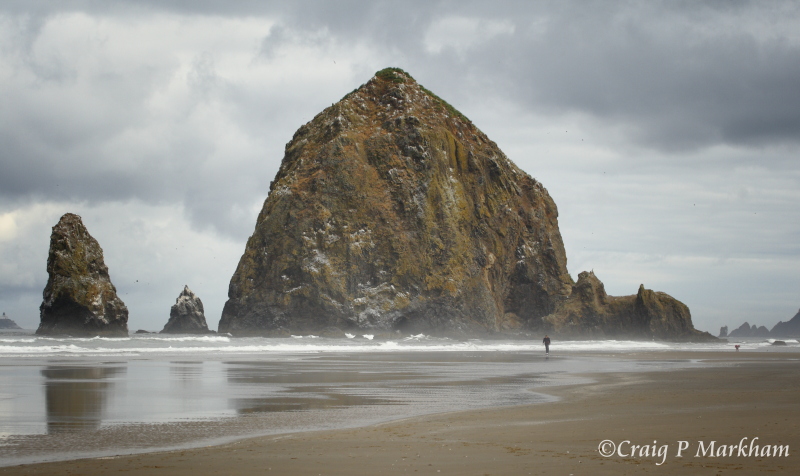NPSO 2014 Annual Meeting
June 6-8, Cannon Beach, OR
 Haystack Rock (C Markham)
Haystack Rock (C Markham)
The Cheahmill Chapter is honored to be hosting the NPSO 2014 Annual Meeting at Cannon Beach.
Cannon Beach on Oregon’s spectacular north coast is the venue for the 2014 Annual Meeting hosted by the Cheahmill Chapter. This charming town, replete with numerous shops, galleries, restaurants, and lodging options, was named for a cannon (from a navy schooner that went aground trying to cross the Columbia River bar) that washed ashore in 1846. William Clark, of the Lewis and Clark Expedition, first laid eyes on the region in 1806 and saw what he called "... the grandest and most pleasing prospects which my eyes ever surveyed, in front of a boundless Ocean..." The headquarters for our meeting is the Surfsand Resort, situated on the shore of this “boundless Ocean” and within easy walking distance from downtown. Field trips will explore temperate rain forests in the coastal fog belt; a swamp with Sitka spruce, western red cedar, and western hemlock; Coast Range rocky balds, such as Saddle Mountain; and estuaries, dune prairies, sea cliffs, and beaches, each with unique plant communities.
Because of its proximity to Portland, the north coast is one of the state’s premier recreation areas, and it includes many historically significant sites, including Fort Stevens, Fort Clatsop and Cape Disappointment, all units of Lewis & Clark National Historical Park. Small beach communities stretch the entire length of the coast, and numerous parks, trails, and roads penetrate the landscape.
The first recorded Euroamerican contact in what is now Cannon Beach took place in the winter of 1805-06 when members of Lewis and Clark’s Corps of Discovery traveled south from Fort Clatsop, their winter encampment near modern-day Astoria, and bartered with Native Americans of the Tillamook tribe for whale blubber and oil. William Clark named Ecola Creek, which enters the Pacific at Cannon Beach, after the Chinook word ehkoli for “whale.” In 1811, Astoria, which is situated at the mouth of the Columbia River, was established as a fur-trading post by John Jacob Astor making it the first American settlement in the Northwest. The cultural history of the north coast is captured in the many historically significant sites, such as Fort Stevens, Fort Clatsop and Cape Disappointment in Lewis & Clark National Historical Park and the beautiful Columbia River Maritime Museum in Astoria.
“The potential for further discoveries is excellent.” So wrote our Saturday banquet speaker Kathleen Sayce in her outstanding article (and source for much of the information presented here), “Botanizing in the Swala-lahos Floristic Area” (Kalmiopsis17, 2010). The Swala-lahos Floristic Area (SFA), which is the focus of our meeting, is part of the larger Coast Range Zone within the Pacific Northwest Rainforest Biome and lies mostly within the summer fog zone. Annual precipitation ranges from 85” at sea level to over 150” at higher elevations and, even though summers tend to be rain-free, in early June we should expect rain (and hope for sunshine).
Most of the forested lands in the region are privately owned and have been logged repeatedly. Less than 10% of the land is conserved, and the parcels that are protected are small and scattered. Nevertheless, the SFA is an area of high species diversity with many endemics, interesting mixes of boreal, xeric/continental, and California taxa, and unique habitats worthy of protection. Despite being extensively and regularly visited by botanists, this floristic region continues to reveal new plant species and range extensions. Since 1986, the North Coast Land Conservancy (NCLC) has taken a leadership role in protecting habitats and connecting the landscape from the tops of mountains to the seashore. Several trips will be led by NCLC members, who will focus on their efforts to restore many of these special sites.
If you are unfamiliar with Oregon’s Coast Range, you might be surprised at how rugged the topography is. The base of the range is an ancient marine rock surface of Eocene basalt that was subsequently covered by layers of marine sediments and ash and lava from volcanic eruptions. Uplift of this oceanic plate as it docked with the North American plate, followed by continued uplift along the latter’s margin, created the Coast Range, which is still crumpling and rising. During the Miocene, Columbia Plateau flood basalts flowed down ancient Columbia River valleys, some flows reaching the ocean and giving rise to what are now the tallest peaks in the area, such as Saddle Mountain (3288’), Angora Peak (2651’), and Onion Peak (3057’). Since the Pleistocene, sea levels have risen 350'. A new subduction zone now pushes under the continent, with attendant earthquakes and tsunamis. The shoreline falls a few meters every few centuries during these events, burying forests. Subsequent erosion, such as from the series of storms that hit the coast in 1997-98, exposes standing dead trees. Such “ghost forests” and buried wood in coastal wetlands are evidence of the last subduction zone earthquake in 1700.
If you have questions that aren't answered here, send email to npsoannmtg2014@gmail.com.